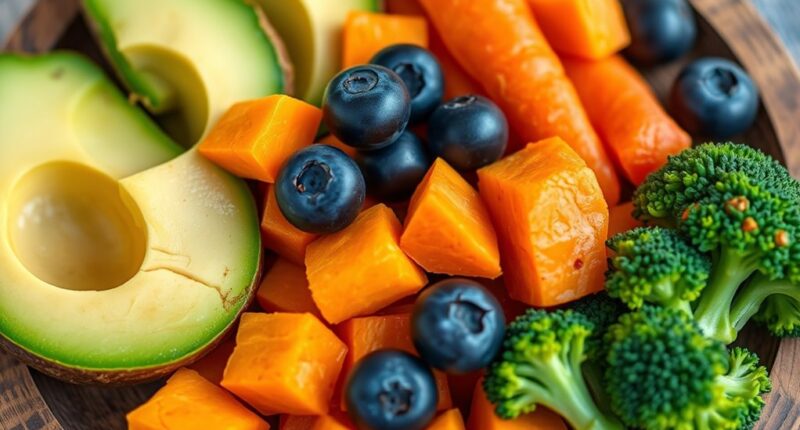To guarantee your toddler gets the right nutrients, include a variety of foods like colorful fruits, such as berries and oranges, to provide vitamins and antioxidants. Incorporate iron-rich options like lean meats or beans for healthy blood development. Offer nutrient-dense dairy or fortified alternatives for calcium and vitamin D. Include whole grains like oats or brown rice for energy, and introduce finger foods like cooked veggies or cheese cubes for self-feeding skills. Keep exploring to find more tips on building a balanced toddler diet.
Key Takeaways
- Incorporate a variety of colorful fruits and vegetables to ensure essential vitamins and minerals.
- Include whole grains like oats, brown rice, and whole wheat for sustained energy.
- Offer lean proteins such as chicken, fish, beans, and eggs to support growth and development.
- Provide dairy products like yogurt, cheese, and milk to promote healthy bones and teeth.
- Introduce healthy fats from sources like avocados, nuts, and seeds for brain development.

Ensuring your toddler eats a balanced variety of foods is essential for healthy growth and development. As you navigate the busy world of parenting, meal planning becomes a vital tool to ensure your little one gets all the nutrients they need. Start by understanding their feeding milestones, which guide you on what textures and foods are appropriate at different ages. For example, when your toddler begins to chew and handle more solid foods, you can introduce a wider range of textures and flavors, making mealtimes more engaging and nutritious.
Understanding feeding milestones helps introduce appropriate textures and foods for healthy toddler development.
Meal planning helps you stay organized and ensures you’re offering a diverse diet. Incorporate foods from all the major food groups, including fruits, vegetables, grains, proteins, and dairy. This balance not only supplies essential vitamins and minerals but also encourages your toddler to develop healthy eating habits early on. For instance, you might plan a week’s worth of meals that include chopped fruits and vegetables, whole grains like oats or brown rice, lean proteins such as chicken or beans, and dairy products like yogurt or cheese. This variety keeps mealtimes interesting and prevents your child from becoming picky.
Pay attention to feeding milestones to introduce new foods at appropriate times. When your toddler starts to show interest in self-feeding, usually around 9 to 12 months, you can offer finger foods like small pieces of soft fruits, cooked vegetables, or cheese cubes. These milestones are opportunities to expand their diet and encourage independence. As your child’s oral motor skills develop, you can gradually increase the complexity of foods, always ensuring they’re manageable and safe.
Understanding feeding milestones can also help you gauge when your child is ready for more textured foods, which is crucial for their oral development and acceptance of a variety of flavors. Consistency in meal planning and understanding feeding milestones also helps you identify any potential gaps in your child’s diet. If your toddler refuses certain foods, it’s important to keep offering them without pressure, knowing that taste preferences can take time to develop. Incorporate a variety of colors and textures to make meals visually appealing, which can entice your little one to try new things. Remember, patience is key—kids often need multiple exposures to new foods before accepting them.
Frequently Asked Questions
When Should I Introduce Allergenic Foods to My Toddler?
You should consider early allergen introduction around 4 to 6 months, as recent guidelines suggest it may help reduce allergy risks. It’s best to consult your pediatrician about allergy testing timing before introducing potential allergens. This way, you can introduce foods like peanuts and eggs safely, monitoring your toddler for reactions. Starting early and following professional advice can promote tolerance and reduce allergy development in your little one.
How Can I Encourage Picky Eaters to Try New Foods?
To encourage picky eaters to try new foods, you can make food exploration fun and stress-free. Offer a variety of colorful, appealing dishes and involve your toddler in choosing or preparing meals. Avoid pressuring them, as it can worsen picky eating. Instead, set a good example, be patient, and keep offering new foods regularly. Over time, your toddler will become more open to trying different flavors and textures.
Are There Vegetarian or Vegan Options for Toddlers?
Oh, absolutely—your toddler can enjoy plant-based meals and vegan snacks just as much as any classic fare! You can introduce colorful veggie purees, tofu scramble, or fruit smoothies that sneak in veggies. Vegan snacks like hummus with veggie sticks or fruit leather keep things fun and nutritious. So, yes, your little one can thrive on a veggie-filled diet without missing out, all while having a tasty, colorful plate!
How Much of Each Food Should My Toddler Be Eating Daily?
You should focus on appropriate portion sizes to guarantee your toddler gets enough nutrients without overeating. Aim for a balanced mix of fruits, vegetables, grains, proteins, and dairy daily. Keep an eye on their hunger cues and avoid force-feeding. A good rule is to offer small, manageable portions and gradually increase as they grow. This helps maintain nutritional balance and supports healthy development.
What Are Safe Ways to Serve Finger Foods to Toddlers?
You might think serving finger foods to toddlers is a tiny task, but it’s actually a big deal! To guarantee safe serving, always cut finger foods into manageable pieces and supervise closely. Opt for soft, easy-to-chew options like cooked veggies or small fruit slices. Keep hot foods cool, and avoid choking hazards. By taking these steps, you make safe serving of finger foods simple and stress-free, protecting your little one while they explore new tastes.
Conclusion
Think of these foods as the building blocks of a strong, vibrant future for your little one. Just as a gardener nurtures each seed to blossom, nourishing your toddler with these nutritious options helps them grow into healthy, happy individuals. By providing a colorful palette of foods, you’re planting the seeds for their well-being. Embrace this journey, knowing you’re guiding them toward a foundation of health that will flourish for years to come.









